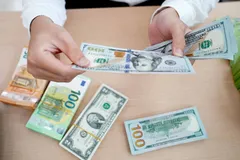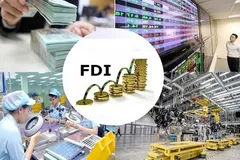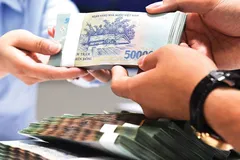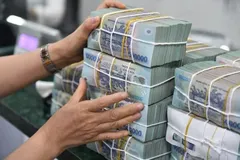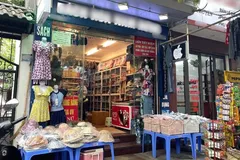
A Short-Term Bottom?
Before the prosecution of former Chairman Nguyen Ho Nam, investor sentiment toward BCG was largely positive. In a February 10 analysis report, a securities firm highlighted BCG’s promising outlook, attributing it to several factors: the energy sector benefiting from Power Plan VIII, the infrastructure sector gaining from public investment, and an optimistic future for real estate.
The firm's assessment of BCG’s potential was largely based on its 2024 financial performance. The company reported net revenue of VND 4,372 billion (a 9% increase) and after-tax profit of VND 844.8 billion (a remarkable 393.8% rise). This growth was driven by contributions from the renewable energy, financial services, and manufacturing sectors. Specifically, revenue from renewable energy reached VND 1,278 billion (up 14%, accounting for 29.2% of total revenue), financial services (mainly insurance) brought in VND 953 billion (up 166.2%, making up 21.8% of revenue), and manufacturing (wood and pharmaceuticals) contributed VND 483 billion (up 101%, accounting for 11% of revenue).
At that time, BCG was trading at around VND 6,000 per share. However, following news of Mr. Nam’s legal troubles on March 1, the stock experienced a sharp sell-off. Over six consecutive trading sessions, BCG plunged from VND 5,760 to VND 3,860 per share—a staggering 33% decline. However, once the price dipped below VND 4,000, a wave of bargain hunters entered the market, pushing the stock back above this threshold.
On investor forums, many have advocated buying BCG shares whenever they fall below VND 4,000, leading to increased demand at this price level. Given this trend, VND 4,000 per share appears to be a short-term support level for BCG.
Concerns About Financial Health
Despite last year’s strong financial results, a deeper analysis of BCG’s financials reveals concerns about asset quality. As of December 31, 2024, receivables made up a significant portion of BCG’s assets, totaling VND 25,728 billion (up 16.6%). Of this, short-term receivables accounted for VND 16,549 billion, primarily from investment cooperation contracts. Despite the high level of receivables, BCG made only minimal provisions for bad debt (VND 56 billion), raising concerns about potential risks to its asset structure.
Additionally, BCG’s total debt stood at over VND 11,580 billion as of December 31, 2024, with long-term debt at VND 8,287 billion, including VND 4,777 billion in bonds maturing within 3–5 years. While BCG’s equity increased to VND 21,394 billion due to a charter capital expansion to VND 8,002 billion, concerns remain about its liquidity and ability to manage future financial obligations.
The company’s capital increase has helped lower its leverage ratio to a safer level. However, BCG still faces significant cash flow pressures due to upcoming bond maturities and its ambitious investments in real estate and renewable energy. Moreover, BCG has posted negative net operating cash flow from 2018 to 2024. As of December 31, 2024, net cash flow from operations was negative VND 1,804 billion, indicating ongoing financial strain.
Following the allegations against Mr. Nam, several securities firms rushed to offload BCG shares. On March 3, 10.6 million BCG shares belonging to Mr. Nam were forcibly sold, reducing his ownership to 81 million shares (9.21% of the company’s charter capital).
Notably, Mr. Nam was not the only insider affected. Several key executives also had shares liquidated. Vice Chairman Nguyen Thanh Hung had 6.5 million shares sold from March 12 to April 10. His wife, Nguyen Xuan Lan, saw 5 million shares liquidated due to a margin call. Additionally, MTV NHN Limited Liability Company (a business owned by Mr. Nam) was forced to sell 5.28 million shares on March 6.
Beyond these stock sales, another concerning development was the Hanoi Stock Exchange (HNX) announcing the suspension of trading for Helios Investment and Services JSC’s HIC12103 bond lot, a company linked to Mr. Nam. The suspension, effective February 25, was carried out under regulations but without a disclosed reason.
According to the official offering disclosure, the HIC12103 bond lot was issued in June 2021 with the objective of expanding working capital, financing mergers and acquisitions, and developing real estate projects. The bonds had a total value of VND 3,000 billion, an original term of 36 months, and an 11% annual interest rate, with an initial maturity date of June 23, 2024. However, in September 2023, Helios extended the bond term to 60 months, pushing the maturity date to June 23, 2026. This extension suggests financial difficulties within Helios.
Helios’ financial performance further supports these concerns. According to its semi-annual financial report, the company reported a loss of VND 41 billion, with equity declining to VND 1,959 billion. The company’s debt-to-equity ratio stood at 3.5 times, translating to an outstanding debt of nearly VND 7,000 billion. Given these figures, investors should be cautious about any indirect exposure BCG might have to Helios’ financial difficulties.
While BCG's stock has seemingly found a short-term bottom around VND 4,000, significant risks remain. The company’s heavy reliance on receivables, substantial debt load, negative cash flow trends, and insider sell-offs all raise red flags. Additionally, the issues surrounding Helios Investment and its bonds introduce further uncertainty.
For risk-tolerant investors, BCG’s recent decline may present an opportunity. However, those considering bottom-fishing should conduct thorough due diligence and be prepared for continued volatility. Without stronger financial stability and clarity on management’s future strategy, BCG remains a high-risk investment in the near term.



